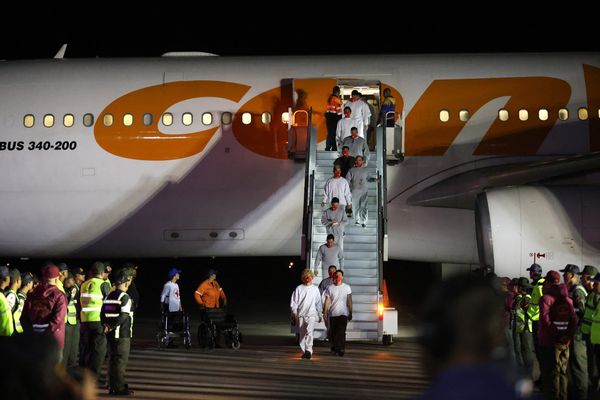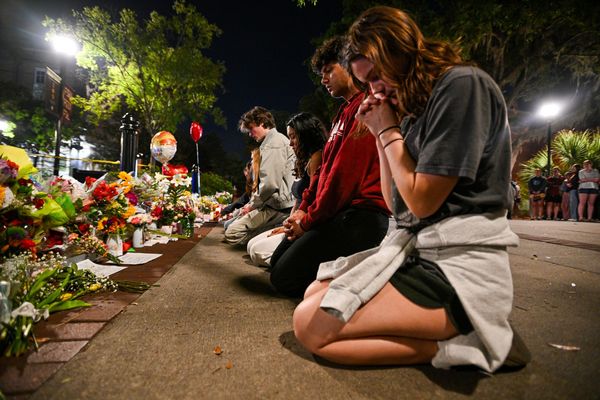
“Have you ever wondered what you’d do if your world is destroyed?” asks 13-year-old Abdullah, speaking at the beginning of an intimate BBC Two documentary, Gaza: How to Survive a Warzone, that airs on Monday night. “Most important, could you stay alive? After all this, you could say we’re experts.”
Abdullah, now 14 and heading back to his prewar home in the north of the shattered territory, is the English-speaking narrator – one of three children whose stories of hope and endurance are at the heart of an hour-long film, a distinctive and deliberate choice intended to make the film resonate after 15 months of war.
In an email exchange via the BBC, Abdullah said he wanted to be part of the programme “to explain the suffering that people here in Gaza witness with the language that the world understands, English” – and so that viewers learn about the situation on the ground without being “blurred by misinformation”.
The documentary also features Renad, 10, who films herself cooking recipes “Gaza style” with her sister while trying to look brave when there is nearby bombing. “I get creative and it relieves my depression,” she says. Her goal (now achieved) is to reach 1 million Instagram followers.
And Zakaria, 11, who helps at the al-Aqsa hospital, where he lives, with the enforced maturity of an adult, transporting the dead and wounded, cleaning the ambulances, and dreaming one day to become a paramedic himself. Blood from patients stains the white gloves he is wearing, though he is barely disconcerted by it.
The product of nine months of filming, the documentary by two BBC producers, Jamie Roberts (whose previous work includes Ukraine: Enemy in the Woods) and Palestinian Yousef Hammash, was not originally to focus so heavily on children but the idea gradually emerged as the two reviewed footage collected by two Palestinian camera operators working in the besieged strip.
“Focusing on children humanises the story,” said Hammash. “The news doesn’t give you a full image – our aim was to go beyond the news. It’s more than a film. The idea was to really engage with people’s living conditions, working with camera operators embedded in Gaza”.
Around half of Gaza’s 2.1 million population are children, but Roberts said they only feature intermittently in news reports. Making them central characters in a documentary, filmed often in intimate close up, is intended to help viewers “see the war through their own eyes,” Roberts said, in an environment from where it has been difficult to report and harder still to follow individual stories.
International media were banned from Gaza from the start of the conflict, and remain unable to access the territory where a fragile peace now holds. But there is an active community of Palestinian journalists and film-makers in the territory and through Hammash the production team were able to recruit two to work on the project.
Amjad Al Fayoumi, a commercial film-maker whose studio in the north had been destroyed, and Ibrahim Abu Ishaiba, who worked in news, went out filming daily, typically after what Roberts said was “an hour-long conversation in the morning” – and constant messaging, often to make sure everybody involved was safe.
The first of the children the team focused on was Zakaria, who was spotted in passing after a bombing at the hospital, while they were filming with a taxi driver. “We saw him in the rushes, and we asked about him – he was well known around the area, and so he popped up as the first child we started to film,” Hammash said.
Safety was an unending concern, the directors said, only partly mitigated by focusing on an Israel designated “safe zone” on the strip, which, as the documentary shows, was regularly bombed. Al Fayoumi’s tent was bombed four times, Hammash said, and at one point he was at the al-Aqsa hospital, from where he refused to leave despite an Israeli evacuation order.
Israeli forces pushed up to the perimeter of the hospital but the paramedics were also intent of staying, fearful that if they left they would not be able to return. “He had got to the state of mind where there is no safe place in Gaza, and thankfully the tanks withdrew,” Roberts said.
Though the trauma of the conflict is well known, the film, though at times unflinching, is often positive. It ends on the hopeful note of the ceasefire announcement – a moment now made more poignant because there are fears the peace will not hold. “Now I have hope,” Renad beams with a sincerity it would be heartbreaking to see extinguished.







